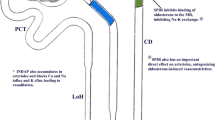Abstract
-
▴ Valsartan/hydrochlorothiazide (HCTZ) combines an angiotensin II AT1 receptor blocker with a thiazide diuretic to produce additive blood pressure reductions without major effects on heart rate.
-
▴ HCTZ did not significantly alter valsartan pharmacokinetics; during combination therapy, HCTZ pharmacokinetics differed from those seen with HCTZ monotherapy.
-
▴ In clinical trials in patients with essential hypertension, adding HCTZ 12.5 or 25 mg/day to valsartan 80 mg/day resulted in a greater blood pressure reduction than increasing the valsartan dosage from 80 to 160 mg/day.
-
▴ The valsartan/HCTZ combination was generally more effective than either drug given alone. Efficacy of the combination was maintained during up to 3 years of treatment.
-
▴ Valsartan/HCTZ was well tolerated in both short and long term trials. The most common adverse events were dizziness, headache and fatigue. The overall incidence of adverse events with the combination was similar to that with placebo. HCTZ-induced hypokalaemia was less common during combination therapy.
Similar content being viewed by others
References
Markham A, Goa KL. Valsartan: a review of its pharmacology and therapeutic use in essential hypertension. Drugs 1997 Aug; 54(2): 299–311
Close P. Expert report on the clinical documentation. Co-Diovan™ 80/12.5 mg film-coated tablets (valsartan/hydrochlorothiazide, CGP 63170). 6 March, 1997. Novartis Pharma AG. Basel, Switzerland
Sica D. Fixed-dose combination antihypertensive drugs: do they have a role in rational therapy? Drugs 1994; 48(1): 16–24
Webb RL, Navarette AE, Davis S. Effects of valsartan and hydrochlorothiazide alone and in combination on blood pressure and heart rate in conscious-telemetered spontaneously hypertensive rats. Am J Hypertens 1998; 11: 59–65
Fujimura Y. Antihypertensive effect of a combination of valsartan and hydrochlorothiazide, nifedipine or propranolol in spontaneously hypertensive rats [in Japanese]. Yakuri to Chiryo 1995 Dec; 23(12): 87–93
Novartis Pharma AG. Data on file. Novartis Pharma AG, Basel, Switzerland
Hall WD, Montoro R, Littlejohn T, et al. Efficacy and tolerability of valsartan in combination with hydrochlorothiazide in essential hypertension. Clin Drug Invest 1998 Sep; 16(3): 203–10
Benz JR, Black HR, Graff A, et al. Valsartan and hydrochlorothiazide in patients with essential hypertension: a multiple dose, double-blind, placebo controlled trial comparing combination therapy with monotherapy. J Hum Hypertens 1998; 12: 861–6
Chrysant SG, Wombolt DG, Feliciano N, et al. Long-term efficacy, safety and tolerability of valsartan and hydrochlorothiazide in patients with essential hypertension. Curr Ther 1998 Nov; 59(11): 762–7
Author information
Authors and Affiliations
Rights and permissions
About this article
Cite this article
Langtry, H.D., McClellan, K.J. Valsartan/Hydrochlorothiazide. Drugs 57, 751–755 (1999). https://doi.org/10.2165/00003495-199957050-00008
Published:
Issue Date:
DOI: https://doi.org/10.2165/00003495-199957050-00008




